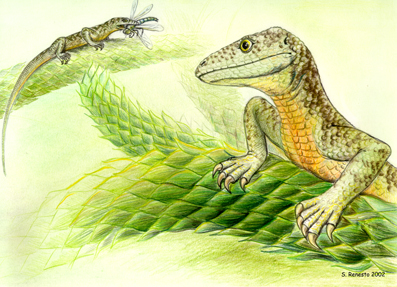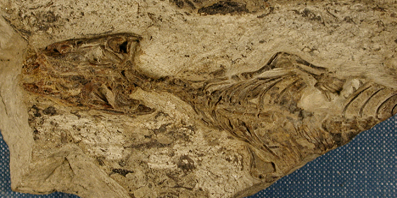
Megachirella

Age: Anisian (Middle Triassic).
Horizon and locality: Monte Prà della Vacca / Kühwiesenkopf area, Braies (Prags), Bolzano(Bozen), Alto Adige, Northern Italy.
The specimen is exposed in dorsal view, apart for the right anterior limb which is exposed on ventral view. The skeleton is incomplete but articulated. The entire snout region is missing, along with the posterior half of the body, the pelvic girdle and the posterior limbs. The right anterior limb is complete, but its distal portion was originally overlapped by ribs. The left humerus is the only preserved element of the left anterior limb. Megachirella is a small diapsid reptile with a rather large skull, moderately elongate neck and stout anterior limbs. The upper temporal fenestrae are large, the lower temporal bar is incomplete, the frontals are fused forming a wide flat table, the parietals are narrow and possibly fused, the parietal foramen is absent; the postfrontals are small, the postorbital show an elongate posterior process, the squamosal is triangular and stout with ventral cotyle for a movable quadrate; the jugal is short, with acaudally pointed posterior process, quadratojugal is absent, the quadrate is lateromedially wide with mobile articulation with the squamosal, there is a stout ascending process and a prominent pterygoid flange anteriorly, it is also present a deep otic notch. The lower jaw is stout bearing robust subpleurodont teeth. Cervical vertebrae are longer than dorsal ones. The vertebrae are amphicoelous, with square neural spines and stout transverse processes. there is a notch between prezygapophyses. Dorsal ribs are single headed, the humerus is stout and distally expanded, bearing complete ectepicondylar and entepicondylar foramina, an ulnar patella is present, unguals are and stout, forming sharp claws.

Megachirella holotype and only known specimen (Renesto and Posenato 2003). To have a scale reference, the humerus is 12.8 mm long
Megachirella does not show any significant synapomorphy of the Archosauromorpha, while it shares some of the derived characters diagnosing the Lepidosauromorpha, namely: a postfrontal which enters the upper temporal fenestra with loss of postorbital-parietal contact, the presence of paired sternal plates, and an interclavicle with an elongate posterior stem.
Within Lepidosauromorpha, Megachirella may be nested within a more restricted assemblage, the Lepidosauriformes (sensu Gauthier et al. 1988) which comprises (Paliguana, Kueheneosauridae + Marmoretta+ Lepidosauria, Evans 1991) on the basis of the presence of the following derived characters: prominent conch formed largely from quadrate, quadrate bowed in lateral view, long paroccipital process which reaches the quadrate, large retroarticular process, quadrate condyle extending below occipital condyle, ectepicondylar foramen complete, first and fifth metacarpals shorter than second and fourth.
Megachirella can be considered with some confidence as belonging to Lepidosauriformes, but any attempt to clarify better its taxonomic position is tentative due to the incompleteness of the skull and poor preservation of postcranial elements.
Megachirella does not show any skeletal correlate which can be considered unequivocally as an adaptation to aquatic life. Many characters speak instead for terrestrial habits, like the robustness of the fore-limbs, the height of the scapular blade, the high level of ossification of the carpus and the size and shape of the claws. In addition, the presence of hollow ribs also speaks against aquatic habits since aquatic reptiles usually show pachyostotic, or at least robust, ribs and massive gastralia which act as a ballast, helping sinking into water. It is thus our opinion that the collected specimen represents an allochthonous terrestrial element transported, together with plants, within a marine marginal basin environment.
Click here to see Megachirella close ups and drawings
Artwork by S. Renesto unless otherwise indicated. Please do not reproduce/repost/republish etc. any text or image without asking permission to the author
Home Research Triassic Reptiles